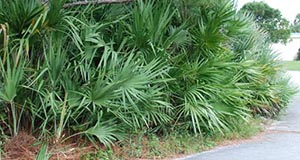Abstract
This publication is intended for anyone interested in identifying and utilizing this Florida native palm in their landscape. Serenoa repens is native to the Southeastern United States and found mostly in Florida coastal woodland coastal locations. Most often referred to as saw palmetto, this slow-growing, small palm only reaches 3–6 feet in height. Its waxy leaves vary in color. The stiff leaves are folded slightly and divided deeply into several dozen segments that split at the tip. Saw palmetto is essentially trunkless and will have 12–30 leaves in total. It has white flowers that bear blue-black fruit. This small palm forms as a ground cover in pinelands along the Southern Coastal Plain. The plants are best established from containers and can be difficult to transplant from the field. Known for its medicinal benefits, the fruits of the saw palmetto are sold in health food stores across the United States and harvested by pharmaceutical companies for medicinal purposes.
References
Hodel, D. R. 2012. The Biology and Management of Landscape Palms. The Britton Fund Inc.
Matrazzo, S., and N. Bissett. 2020. Native Plants for Florida Gardens. Pineapple Press.
Meerow, A. W. 1992. Betrock’s Guide to Landscape Palms. Betrock Information Systems.
Riffle, R. L., P. Craft, and S. Zona. 2012. The Encyclopedia of Cultivated Palms. 2nd ed. Timber Press.

This work is licensed under a Creative Commons Attribution-NonCommercial-NoDerivatives 4.0 International License.
Copyright (c) 2025 UF/IFAS

